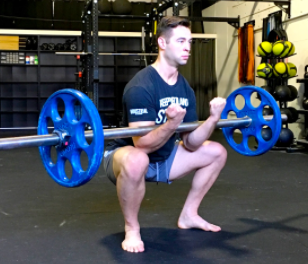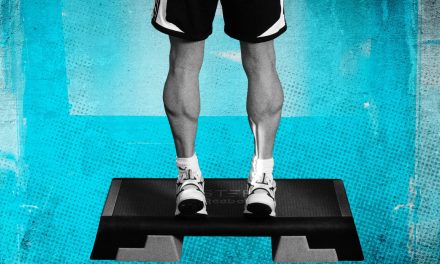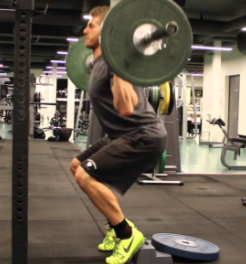When most coaches discuss methods of getting stronger, they are actually explaining training methods for muscle hypertrophy. Muscle hypertrophy is a great goal and will help improve power, strength, and speed, but does not guarantee the athlete will move fluidly and effortlessly. If a person is not playing sports and wants only to become more attractive or feel stronger, then muscle building is the way to go. If a person wants to be more athletic, then muscle building is going to be only one of many training components.
Football coaches talk constantly about getting bigger because it is very important. But the bodybuilding world sometimes bleeds into the sports world too much, so the focus stays on getting big instead of getting big and athletic. The bodybuilding community can definitely help athletic development coaches, as I read a lot of information coming from that world. That being said, it is important to know how to apply that information so we do not train only for hypertrophy. Athletes need their nervous system functions to improve along with their hypertrophy. Just because someone has big muscles does not mean they can run fast, be agile, have great reaction time, or be coordinated.
Strength and sport-specific coaches should be constantly thinking about how their programming affects their athletes’ nervous systems so they can prepare them for the rigors of playing each particular sport. One of the ways to do this is to create training protocols where the nervous system learns to recruit the proper amount of muscle fiber for different activities.
SIMPLE SCIENCE OF MOTOR UNITS
Have you ever wondered why you can pick up a heavy table at home and then immediately pick up a child while using the proper amount of strength and power that is appropriate for each? The reason why you can do both properly is because the nervous system tells the muscles which fibers need to activate, how many need to activate, and at the proper intensity.
The scientific answer to the question above revolves around motor units. The partnership between the motor neuron and muscle fibers is called a motor unit and multiple motor units working together is called a motor pool.
In the eye, some motor units are made up of one neuron for every muscle fiber. The more precision that is needed, the fewer muscle fibers are connected to each motor neuron. There are other situations like the quadriceps, where there are a lot of muscle fibers for each motor neuron. On average, there are about 150 muscle fibers per motor neuron. The moral of the story is the motor neurons determine which and how many muscle fibers are required to successfully resist or produce forces. This is why a person can properly go back and forth between lifting heavy objects and then picking up a child. The motor neuron causes more muscle fibers to contract when lifting a heavy object and much less for picking up a child. If the body did not work that way, we would not be able to lift heavy objects while also crushing young children.
Basically, the nervous system is smart enough to recruit the least amount of muscle fiber needed to perform a particular action. This makes a lot of sense because the body should use the least amount of energy possible for each task and store the rest. If the body did not do this, our endurance would suffer because every action would occur at maximum effort.
It is important to note that muscles cannot think for themselves and therefore do not cause “muscle memory.” The motor neurons do all of the thinking for the fibers and tell them when to activate and what to do. There is “motor neuron memory” and that can be trained through a variety of training methods and should be a focus of all programming.
To discuss motor units in a digestible manner, most coaches understand them more easily through the lens of lifting weights. If an athlete does a set until failure, their motor neurons are going to need to fire in a certain way. The motor neurons will recruit the minimum number of motor units for the first rep and since those muscle fibers will get tired, they will recruit more motor units for the second rep. This pattern continues until all fibers have been exhausted and an athlete cannot perform the task again until they have rested. If you want the lifter to get to their failure point quicker, then you just make them lift more weight because more muscle fiber recruitment will happen at a faster pace which will cause the failure to occur more quickly.
When it comes to sports, every coach has to know what kind of muscle recruitment they want so they can create proper programming. Throwing, sprinting, hitting, and kicking all require maximum muscle recruitment to perform them well. For long distance running, I do not want maximum muscle fiber engagement because the athletes will get too tired too quickly and not be able to perform the same repetitive action for a long duration. In terms of throwing, quarterbacks will want more recruitment for a deep throw than a short throw. I have heard quarterback coaches tell their players to throw the ball “to” the receivers and not “through” them. This is a perfect example of the motor neuron being in control of the muscle fibers. For offensive lineman, a higher muscle fiber recruitment and intensity is usually ideal since they are trying to push and resist very high forces every play. Keep in mind though that it is important to train both for power and stamina because all of our players need both.
Once I learned these concepts, I began to understand more why coaches were doing what they are doing. Here are some workout concepts that made a lot more sense to me once I had a deeper understanding about the role of motor units.
USING PERCENTAGES
Many programs use percentages to tell athletes how much weight to use each set. With boys, this is a good idea because unless told otherwise, they are always going to put on too much weight and do it with terrible technique. The advantage of using percentages is that it forces the athletes to use appropriate weights which will allow each lifter to have a better chance of meeting the workout goals. If players inappropriately pick their weights for a given set and repetition combination, they will either tire too quickly because they will have to recruit too many motor units too quickly, or never tire because they did not recruit enough motor units for each repetition. If an athlete is doing five sets of three, and picks a weight leading them to perform only one rep on the first set, then they are not going to reap the benefits of that day’s programming. If they pick a weight that they can easily do eight times, the set of three will also be wasted.
There are some disadvantages to using percentages. Sometimes percentages make the kids stop thinking about their workouts and turn them into robots. The percentages should be a guide but not a hard rule. The athletes should know that if they are feeling really good, then they should use slightly more weight. But if they are struggling on a particular day, they should use slightly less weight to make sure they are hitting their programmed repetitions.
ONE-REP MAX
The point of the one-rep max is to find out how strong someone is by determining how much they can lift when all of their motor units fire simultaneously. Just because someone can do a certain weight for a certain number of reps does not automatically mean that they can do their calculated one-rep max. I completely understand why coaches do calculated maxes because it is safer, but the one-rep max charts are not completely accurate because they are only estimates. In my experience, the chart only works for estimates of up to three reps and most charts also do not go past 10 reps.
To show the margin of error of a one-rep max chart, I once did 16 reps at 185 lbs on bench press which lead to my one-rep max estimate being 285 lbs. There is no possible way I would have been able to recruit a motor pool capable of lifting 285 lbs. At that time, I was doing a lot of high repetition workouts and my endurance was great, but my power and strength were not sufficient to lift 285 lbs. If I wanted to start lifting heavier weights, I would have needed to train at lower reps so my motor units learned to fire at once. Keep in mind that the body only knows what it is taught.
When I test athletes they are allowed to do a weight up to three reps and then I calculate their one-rep max. If they can do more repetitions than three, we make them stop at three repetitions because the margin of error for calculating their max will be too great. We also make this decision because they should know about how much they can do since we do a lot of low rep sets. On top of that, if they do not know how much they should try for, then they have not been paying attention or they have not been doing enough weight during the workout. This example is actually another argument for using percentages so there is a constant reminder of what weight they can and should do.
SET & REP CHOICES
Coaches are constantly talking about the proper set and rep ranges that should be used in programs. In terms of motor unit activation, low rep ranges are going to be your best bet. This is one of the reasons why most programs have flipped their sets and reps. Instead of doing 3×8, they will do 8×3 instead. If you do 8×3, the motor unit activation is higher and the same amount of repetitions are accomplished. In my experience, the hypertrophy is greater because more muscle fibers are activated and are used more often. There is also a conditioning component to 8×3 since there are so many sets and the high motor unit activation causes fatigue. If this is applied to offensive lineman, the game consists of using maximum motor unit recruitment, having a quick break, and then doing it again. The 8×3 combination is much more applicable than the 3×8 sets.
COMPOUND MOVEMENTS
Why are Squats better than Leg Curls? If the argument is just about motor units, the motor pool is much larger for compound movements than isolation movements since more motor units need to be activated in a multi-joint movement. Squats are going to train the nervous system much differently than Leg Curls because of the number of muscles that have to work together. In terms of the nervous system, it is always better to do compound movements because these movements will translate into general athletic skills, like jumping and sprinting, and to sport-specific skills like blocking and tackling.
FUTURE ARTICLES
Now that you are thinking about how to train the nervous system, there will be future articles on how to apply this information to training philosophies, programming, and how to adjust exercises to promote nervous system development while also training for strength, size, and speed.
If you are interested in learning more you can go to the resources page on my website (https://exceleratead.com/training-theory) to find my FREE and moderately priced CoachTube Courses, Coaches Choice Videos, and a variety of other training articles and resources. My contact information is on my website so please feel free to email me with any questions.





